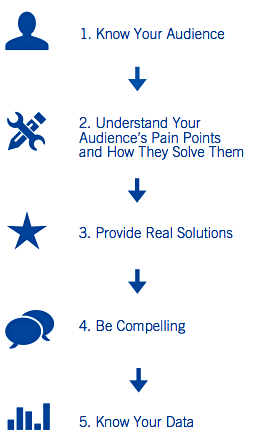 It’s easy for online B2B marketers to become distracted by the search engines and forget the real reason they’re doing SEO in the first place: the customer. Customer demand is the driving force behind search and must be the foundation for your SEO strategy. Whether you’re an SEO newbie or already running a few SEO campaigns, it’s important to take a step back and determine what techniques really align with your customers’ needs.
It’s easy for online B2B marketers to become distracted by the search engines and forget the real reason they’re doing SEO in the first place: the customer. Customer demand is the driving force behind search and must be the foundation for your SEO strategy. Whether you’re an SEO newbie or already running a few SEO campaigns, it’s important to take a step back and determine what techniques really align with your customers’ needs.
An effective, simple concept every search marketer should leverage is the process of developing a search persona. Similar to a marketing persona, creating a search persona helps professional B2B marketers to accurately identify their target customer, to understand how users are actually searching for their business online and to ultimately, drive higher conversion. This is not a very time-consuming process, and will have a significant impact on your marketing efforts behind search and must be the foundation for your SEO strategy. Understanding the keywords your prospects use and the places they go to find information is the critical first step in implementing a successful inbound marketing strategy
1. Know Your Target Audience
Identify a target audience that is most likely to turn into customers. Ask yourself: Who’s my perfect buyer? For any businessperson (regardless of SEO), this is something you should be able to answer.
2. Understand Your Audience’s Pain Point(s) & Know How They Search to Solve Them
How would your target customer articulate their need for this in terms of keywords? How do they search? Determine the queries that are used by your target audience, are aligned with your business goals, and appear in significant enough volumes.
3. Provide Real Solutions
Create great content that’s well optimized for the search engines, but also meets the needs of your target customer and provides calls-to-action that encourage users to further explore and engage with your product or service.
4. Be Compelling
Offer a call to action that compels the searcher to dive deeper into your conversion funnel. For example,
this might be a discount code, or an online form. Basically, a feature that allows you to keep in contact with a user and offers them an incentive to stay engaged with your website and product or service.
5. Know Your Data
Make sure you’re regularly tracking performance metrics that help demonstrate the efficacy of these campaigns.
One of the most overlooked aspects of this process is to truly try to understand the target searcher’s agenda. Think of yourself as you search for something. All the pages you bounce off of, because they aren’t relevant, trustworthy, or are too complex for one reason or another. Search persona only works in context with business goals, and content that was designed for them. Doing only one thing out of the overall list above will not bring the desired results. Now that you’ve built your search persona, examine your website’s content and existing SEO campaigns and make any adjustments necessary to align with the criteria you’ve identified in this process. Understanding the keywords your prospects use and the places they go to find information is the critical first step in implementing a successful inbound marketing strategy.
This article is excerpted from a whitepaper by Optify Inbound Marketing Software. Learn more.





